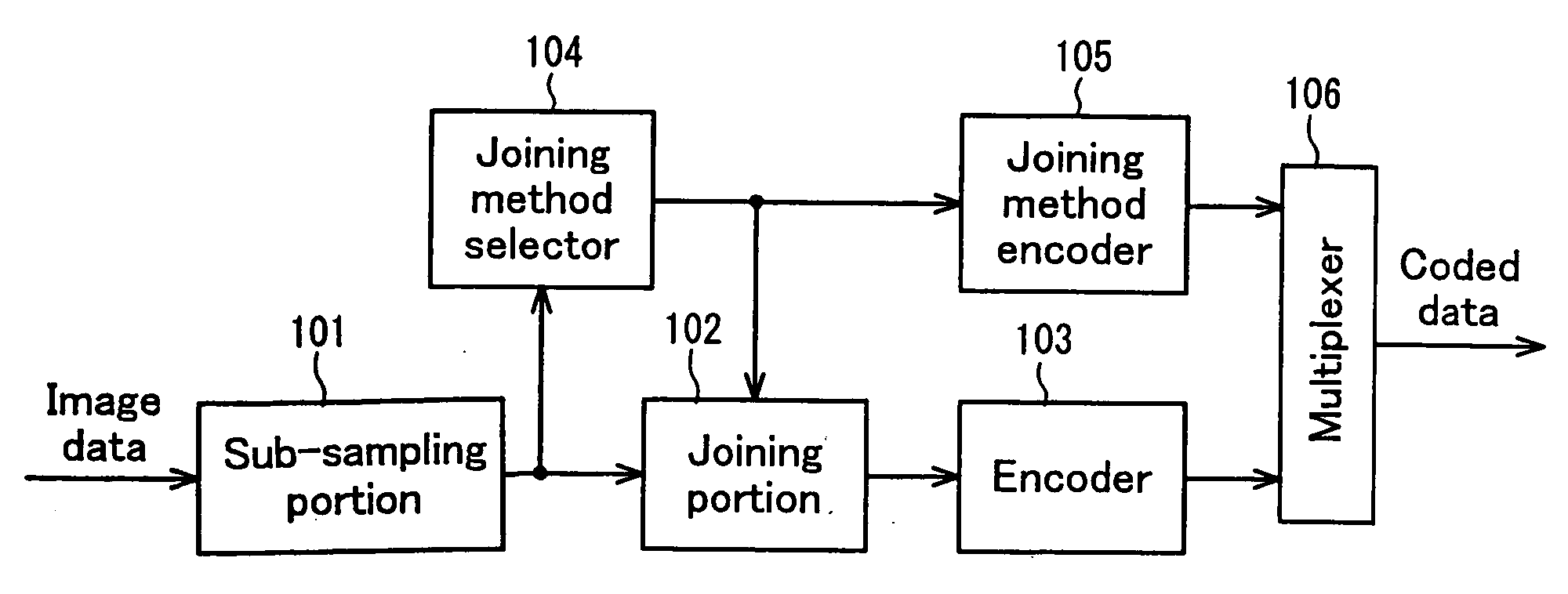Image encodder, image decoder, record medium, and image recorder
a technology of image encoder and image, which is applied in the field of image encoder, image encoder, recording medium and image recording apparatus, can solve the problems of low coding efficiency, large dct coefficient high-frequency components, and low coding efficiency, so as to facilitate post-recording modification, facilitate handling, and facilitate the effect of recording
- Summary
- Abstract
- Description
- Claims
- Application Information
AI Technical Summary
Benefits of technology
Problems solved by technology
Method used
Image
Examples
first embodiment
The First Embodiment
[0086]FIG. 1 is a block diagram showing an image coding apparatus of the first embodiment of the present invention. A sub-sampling portion 101 is a portion that sub-samples images of data; a joining portion 102 is a portion that joins the sub-sampled images of data; an encoder 103 is a portion that encodes the joined image data; a joining method selector 104 is a portion that selects an image data joining method from a plurality of joining methods; a joining method encoder 105 is a portion that encodes the information of the selected joining method; and a multiplexer 106 is a portion that multiplexes the encoded image data and the encoded information of the joining method to generate coded data.
[0087] Now, the image coding apparatus of the first embodiment will be described in detail with reference to the drawings.
[0088] Sub-sampling portion 101 sub-samples the input image data to half with respect to the horizontal direction, in the same manner as described in...
second embodiment
The Second Embodiment
[0127] Next, the second embodiment of the present invention will be described. In the first embodiment, the input images viewed from different viewpoints are input time-sequentially. In the second embodiment, the input images viewed from different viewpoints can be input in parallel.
[0128]FIG. 6 is a block diagram showing an image coding apparatus of the second embodiment. A first sub-sampling portion 601 and second sub-sampling portion 607 are portions that sub-sample image data; a joining portion 602 is a portion that joins the sub-sampled images of data; and a joining method selector 604 is a portion that selects the image data joining method from multiple joining methods. An encoder 603, a joining method encoder 605 and a multiplexer 606 provide the same functions as in the configuration of FIG. 1, so that description is omitted herein.
[0129] First sub-sampling portion 601 sub-samples the input right image and second sub-sampling portion 607 sub-samples th...
third embodiment
The Third Embodiment
[0133] Next, the third embodiment of the present invention will be described. This embodiment is characterized by linking the selecting process of the joining method with the coding process.
[0134]FIG. 7 is a diagram showing an example of coding a movie. Here, the figures represent the frame numbers of the frames. The symbol added to each coded frame represents the type of coding. Specifically, I indicates that the frame is coded by intra-frame coding, P indicates that the frame is coded by inter-frame coding.
[0135] In the example of FIG. 7, frame 0 is coded by intra-frame coding, frames 1 and 2 are omitted without being coded, frame 3 is coded by inter-frame coding. Similarly, frames 6 and 10 are coded by inter-frame coding, and frame 14 is coded next by intra-frame coding.
[0136] It is wasteful to effect a selection process of the joining method every frame in a coding scheme entailing frame-skipping. Therefore, in the third embodiment, in the image coding app...
PUM
 Login to View More
Login to View More Abstract
Description
Claims
Application Information
 Login to View More
Login to View More - R&D
- Intellectual Property
- Life Sciences
- Materials
- Tech Scout
- Unparalleled Data Quality
- Higher Quality Content
- 60% Fewer Hallucinations
Browse by: Latest US Patents, China's latest patents, Technical Efficacy Thesaurus, Application Domain, Technology Topic, Popular Technical Reports.
© 2025 PatSnap. All rights reserved.Legal|Privacy policy|Modern Slavery Act Transparency Statement|Sitemap|About US| Contact US: help@patsnap.com



